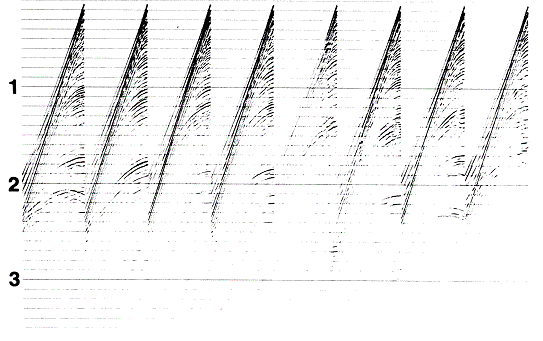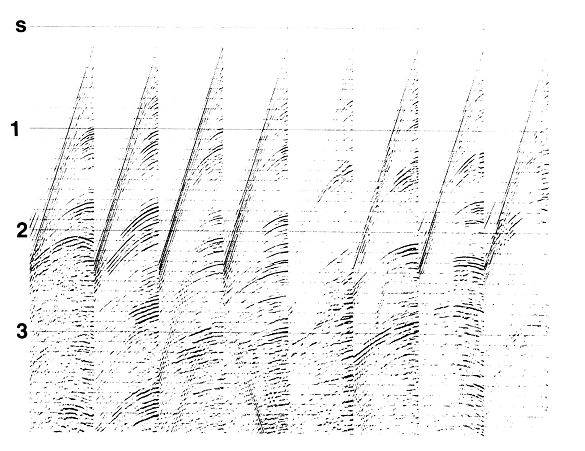
The data recorded in the field multiplexed, that is, samples from more than one trace are mixed in a record. During loading the data is demultiplexed and converted into a format used in the rest of the processing. The format depends upon the system used to process the data. An example of demultiplexed a few common shot gathers from a 2D acquisition is shown in the figure below. Note that the earlier arrivals are the strongest while arrivals coming later in the trace from deeper reflectors are weaker. The vertical axis is in seconds.

Figure 20 Common shot gathers after demultipexing (Yilmaz, 1987)
Trace editing deletes those traces with noise glitches and traces from consistently noisy hydrophones or geophones. The noise may come from defects in the equipment or sources such as cars, boats, machinery, or random noises in the acquisition environment.
Gain recovery is used to compensate for energy loss as the wavefront travels through the earth. As noted earlier the wavefront propagates away from the source in all directions. The result is that the further away from the source the less energy there is at any point and the reflections become weaker. A correction is applied to the data to compensate for this spherical divergence. The gain applied becomes greater the as one moves down the trace. The energy in the wavefront is also reduced by attenuation, which is primarily caused by conversion of vibrational energy into heat. An exponential gain factor may also be applied at this stage to compensate for the effects of attenuation. The figure below shows the shotpoint gathers with divergence correction applied. Note that the amplitudes of the later arrivals have been greater increased.

Figure 21 Common shot gather after divergence correction (Yilmaz,1987)
Bandpass filtering is used to eliminate coherent noise. It has previously been noted that the signal produced by seismic sources is frequency band limited. Any part of the signal that is outside the frequency range produced by the source is noise and may be removed. Monofrequency, for example, 50 or 60 Hertz noise, or other limited bandwith noise that may have been introduced by the equipment or the environment but which is not serious enough to cause the entire trace to be rejected in the trace editing phase may also be filtered out in this step.
The field geometry, or information about the location and elevation of the sources and receivers is taken from the filed tapes. This is use to make static corrections to adjust all the traces to a common reference elevation, or datum, such as mean sea level. A static correction is constant time shift made to an entire trace. Since each source and each receiver may be at a different elevation, the correction applied to a trace is the sum of the correction for the receiver elevation and the source elevation.